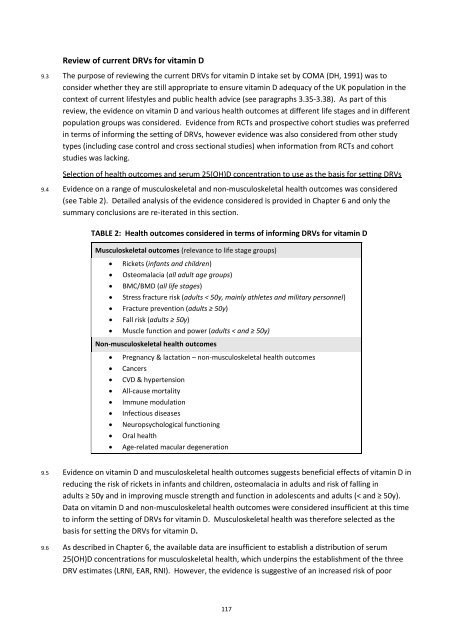Vitamin D and Health
SACN_Vitamin_D_and_Health_report
SACN_Vitamin_D_and_Health_report
You also want an ePaper? Increase the reach of your titles
YUMPU automatically turns print PDFs into web optimized ePapers that Google loves.
Review of current DRVs for vitamin D<br />
9.3 The purpose of reviewing the current DRVs for vitamin D intake set by COMA (DH, 1991) was to<br />
consider whether they are still appropriate to ensure vitamin D adequacy of the UK population in the<br />
context of current lifestyles <strong>and</strong> public health advice (see paragraphs 3.35-3.38). As part of this<br />
review, the evidence on vitamin D <strong>and</strong> various health outcomes at different life stages <strong>and</strong> in different<br />
population groups was considered. Evidence from RCTs <strong>and</strong> prospective cohort studies was preferred<br />
in terms of informing the setting of DRVs, however evidence was also considered from other study<br />
types (including case control <strong>and</strong> cross sectional studies) when information from RCTs <strong>and</strong> cohort<br />
studies was lacking.<br />
Selection of health outcomes <strong>and</strong> serum 25(OH)D concentration to use as the basis for setting DRVs<br />
9.4 Evidence on a range of musculoskeletal <strong>and</strong> non-musculoskeletal health outcomes was considered<br />
(see Table 2). Detailed analysis of the evidence considered is provided in Chapter 6 <strong>and</strong> only the<br />
summary conclusions are re-iterated in this section.<br />
TABLE 2: <strong>Health</strong> outcomes considered in terms of informing DRVs for vitamin D<br />
Musculoskeletal outcomes (relevance to life stage groups)<br />
<br />
<br />
<br />
<br />
Rickets (infants <strong>and</strong> children)<br />
Osteomalacia (all adult age groups)<br />
BMC/BMD (all life stages)<br />
Stress fracture risk (adults < 50y, mainly athletes <strong>and</strong> military personnel)<br />
Fracture prevention (adults ≥ 50y)<br />
Fall risk (adults ≥ 50y)<br />
Muscle function <strong>and</strong> power (adults < <strong>and</strong> ≥ 50y)<br />
Non-musculoskeletal health outcomes<br />
<br />
<br />
<br />
<br />
<br />
<br />
<br />
<br />
<br />
Pregnancy & lactation – non-musculoskeletal health outcomes<br />
Cancers<br />
CVD & hypertension<br />
All-cause mortality<br />
Immune modulation<br />
Infectious diseases<br />
Neuropsychological functioning<br />
Oral health<br />
Age-related macular degeneration<br />
9.5 Evidence on vitamin D <strong>and</strong> musculoskeletal health outcomes suggests beneficial effects of vitamin D in<br />
reducing the risk of rickets in infants <strong>and</strong> children, osteomalacia in adults <strong>and</strong> risk of falling in<br />
adults ≥ 50y <strong>and</strong> in improving muscle strength <strong>and</strong> function in adolescents <strong>and</strong> adults (< <strong>and</strong> ≥ 50y).<br />
Data on vitamin D <strong>and</strong> non-musculoskeletal health outcomes were considered insufficient at this time<br />
to inform the setting of DRVs for vitamin D. Musculoskeletal health was therefore selected as the<br />
basis for setting the DRVs for vitamin D.<br />
9.6 As described in Chapter 6, the available data are insufficient to establish a distribution of serum<br />
25(OH)D concentrations for musculoskeletal health, which underpins the establishment of the three<br />
DRV estimates (LRNI, EAR, RNI). However, the evidence is suggestive of an increased risk of poor<br />
117


